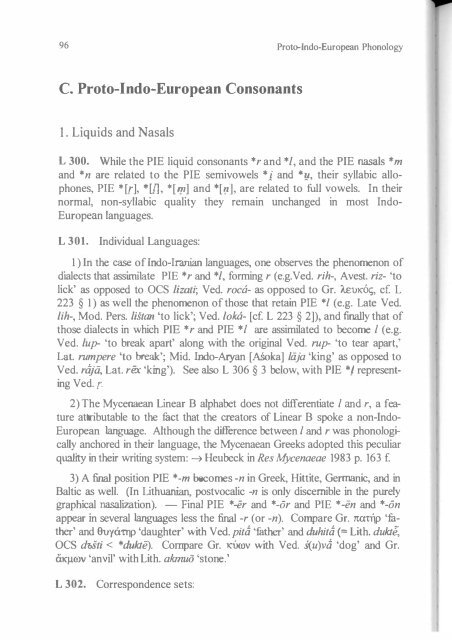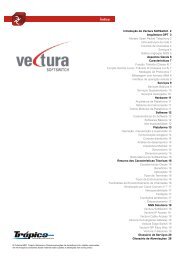Create successful ePaper yourself
Turn your PDF publications into a flip-book with our unique Google optimized e-Paper software.
96 Proto-lndo-European PhonologyC. Proto-Indo-European ConsonantsI. Liquids and NasalsL 300. While the PIE liquid consonants ·r and ·1, and the PIE nasals .mand ·n are related to the PIE semivowels .j and . !!, their syllabic allophones,PIE .[r], ·W, .['!'] and .[(1], are related to full vowels. In theirnormal, non-syllabic quality they remain unchangedEuropean languages.L 301. Individual Languages:in most IndoI) In the case <strong>of</strong>lndo-lranian languages, one observes the phenomenon <strong>of</strong>dialects that assirnilate PIE ·r and ·1, forming r (e.g.Ved. rih-, Avest. riz- 'tolick' as opposed to OCS lizati; Ved. roca- as opposed to Gr. AeUK, cf L223 § I) as well the phenomenon <strong>of</strong> those that retain PIE ·1 (e.g. Late Ved.lih-, Mod. Pers. listan 'to lick'; Ved. lokti- [cf L 223 § 2]), and finally that <strong>of</strong>those dialects in which PIE ·r and PIE ·I are assimilated to become I (e.g.Ved. lup- 'to break apart' along with the original Ved. rup- 'to tear apart,'Lat. rumpere 'to break'; Mid. lndo-Aryan [ASoka] laja 'king' as opposed toVed. raja, Lat. rex 'king'). See also L 306 § 3 below, with PIE ., representingVed. r2) The Mycenaean Linear B alphabet does not differentiate I and r, a featurealtnbutable to the fuet that the creators <strong>of</strong> Linear B spoke a oon-IndoEuropean language. Although the difference between I and r was phonologicaIIyanchored in their language, the Mycenaean Greeks adopted this peculiarquality in their writing system: Heubeck in Res Mycenaeae 1983 p. 163 f3) A finaJ position PIE ·-m becomes -n in Greek, Hittite, Germanic, and inBaltic as well. (In Lithuanian, postvocalic -n is only discemible in the purelygraphical nasalization). - Final PIE ·-er and ·-or and PIE ·-en and *-onappear in several languages less the finaJ -r (or -n). Compare Gr. 1tOtTtP 'father'and 8uyOTl]P 'daughter' with Ved. pita 'father' and duhita (= Lith. dukte,OCS d7>.5ti < *dukt€). Compare Gr. MV with Ved. S(u)va 'dog' and Gr.iiKIlOlV 'anvil' with Lith. akmuo 'stone.'L 302. Correspondence sets:Proto-lndo-European Consonants 97I) PIE or: - PIE ·doru- n. 'wood' (For declension, cf F 317 § 8) = Gr.oopu, Ved. daru, Hitt. ta-ru-u-i, i.e. ta,!!i dat. _loc. sg.; compare Got. (rlU,OCS drevo 'tree.' - PIE *mijes 'three' (Lat. Ires etc., cf. L 215 § I).mel, . IffiAl-O ah, and the assimilation <strong>of</strong> -ms > -n ) leads to _Pre-PIE*-ans, and from there, > PIE ·-as. Compare Ved. -as, Got. -os. ( J.





